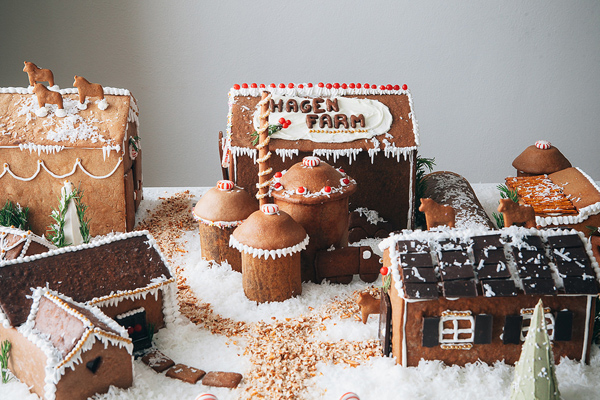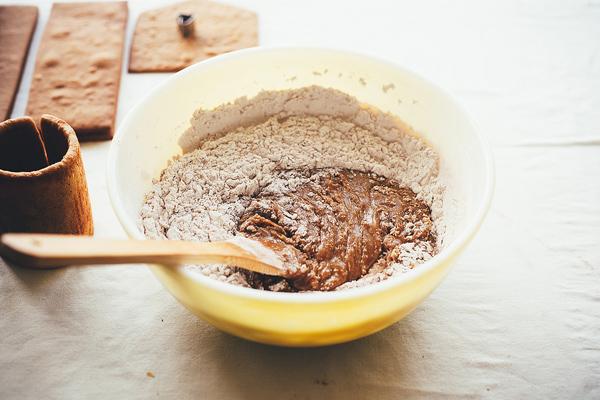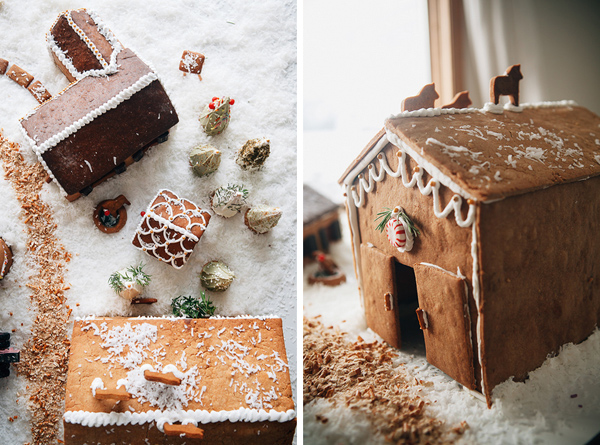How to build a beautiful gingerbread farm
And yes, you can eat it, too


Welcome to my farm, where fresh coconut snow is always on the ground and life smells of cinnamon and dark chocolate. As I take you on this tour, please feel free to interact with the buildings: Nibble on the doors, have a bite of the gravel roads, lick the windows — it's all edible! (And not in a Violet Beauregarde way, I promise.) This is a three-day tour, so your legs may get a bit tired, but don't worry: A blue raspberry hot tub awaits you at the end.
First, let's discuss the walls on this farm. They are built to withstand nearly every natural disaster: harsh Midwest winters, swinging arms of toddlers, even land buyouts that will force you to move your house from one plot (the kitchen table) to another (the coffee table?). In the back of the farm, you'll see two storage buildings identical in size, but of different shades of brown. This is where we keep our tractors and combines.

The garage on the left was made with dark corn syrup, while the darker building on the right that says Hagen Farm was made with molasses. We now interrupt this tour for a brief, instructional interlude on how to make your own gingerbread house:
The Week
Escape your echo chamber. Get the facts behind the news, plus analysis from multiple perspectives.

Sign up for The Week's Free Newsletters
From our morning news briefing to a weekly Good News Newsletter, get the best of The Week delivered directly to your inbox.
From our morning news briefing to a weekly Good News Newsletter, get the best of The Week delivered directly to your inbox.
Makes 1 large house
1 cup dark corn syrup, molasses, or a mix of the two (corn syrup for lighter colored walls, molasses for darker walls)
3/4 cup dark brown sugar
A free daily email with the biggest news stories of the day – and the best features from TheWeek.com
3/4 cup margarine or butter
4 cups all-purpose flour
2 teaspoons ground cinnamon
1/2 teaspoon ground ginger
In a medium saucepan or microwave-safe bowl, combine corn syrup or molasses, brown sugar, and margarine or butter. Heat this until the margarine or butter is melted and the sugar has completely dissolved, either over medium heat on the stovetop or in the microwave in 1-minute increments, stirring in between each zap.
In a large bowl, combine all of the dry ingredients. Stir in the sugar mixture until combined. Cover with plastic wrap and let cool at room temperature for 20 to 30 minutes.

Meanwhile, preheat oven to 350° F and get your stencils ready. You can either make them or find them online. The engineers of this farm used a fairly simple way of constructing these buildings using cardboard stencils, made with a ruler and a razor blade:

Start by making a stencil for the front and back of the house (above left):
- Draw a horizontal line (the width of the house) on a piece of cardboard, and then draw a line perpendicular to the midpoint of that line (the length of this line will be the height of the house's peak).
- Draw two more shorter lines perpendicular to that middle line, and then draw diagonal lines connecting those to the center line. Cut this out with a razor.
Next, make a template for the sides of the house (above right): This will be a rectangle that has the same height as the shorter vertical lines of the front and back of the house.

Finally, make the roof, a rectangle that is about 1/2 inch longer than the sides of the house and 1/2 to 1 inch wider than the diagonal lines in the front and back of the house. This will ensure that it hangs over both the ends and sides of the house.
Roll your dough out onto a piece of parchment paper that's fitted with a cookie sheet. Lightly flour the dough and place your stencils on top (leaving 1 inch in between them). Use a pizza cutter or sharp knife to trace around them.
Remove excess dough, slide the parchment onto your cookie sheet, and then bake until the edges just start to brown. Begin checking for doneness at 15 minutes. If you'd like a darker brown color, you can leave them in there for up to 45 minutes. You can re-roll your dough scraps a few times. If it starts to feel dry, microwave it for 30 seconds or so.

Now back to our tour! Below you see the farm house where my fiancé and I live. Its walls were built with a custom blend of 1/4 cup corn syrup and 3/4 cup molasses. The deep dark color of the roof was achieved through a highly specialized technique that our builders like to call "forgetting that they were in the oven and baking them for 45 minutes."


I've noticed some of you admiring the windows of the houses on this farm. They're delicious and fruity, made by filling cutouts in the dough with crushed Jolly Ranchers before they get baked. They're a favorite among our horsies, which by the way are quite friendly. You should pet them. They won't bite (they don't actually have mouths).

Up ahead you'll see our grain bins, the largest of which can hold up to 40,000 bushels of hard red spring wheat.

These grain bins and our quonset are made by molding hot gingerbread that is fresh out of the oven around a can. The gingerbread is held there until it cools.

Because of the attention that these grain bins need, they should be baked and molded one at a time. A cinnamon stick grain leg helps to load our grain into our trucks, which is then taken to the town plant and processed into flour for things like…gingerbread!

If you run your hands along the edges of our buildings, you'll find that the mortar is extremely hard and sturdy. It helps to keep the drafts out and the warmth in. Here's how to make your own:
Makes enough for 1 house and a ton of decorations (or a few houses and a few decorations)
3 large egg whites
1/2 teaspoon cream of tartar
4 cups powdered sugar
In a large bowl or bowl of a stand mixer fitted with a whisk attachment, beat together the egg whites and cream of tartar until the mixture is foamy. Gradually beat in the powdered sugar, then beat on medium high for 7 to 10 minutes, until very fluffy. Immediately spoon it into a piping bag and use. Any frosting that's not being used should remain under plastic wrap (the plastic wrap should touch the surface of the frosting) so that it doesn't dry out.

When the houses are built, a big piped line of mortar glues together the walls.

An extra line is added on the inside for reinforcement, and then any excess on the outside is scraped away to allow for embellishments that are added after the house dries.

Once the walls are dry and sturdy, the roof is added in the same way. The houses only take about 15 to 20 minutes to dry, and then it is time for the fun part.

As you can see, our artistic directors and landscapers at the farm were inspired by earth tones, herbs, and small pops of gold and red. Chocolate shingles cover the roof of our workshop and chocolate shutters surround the windows, while rosemary bushes miraculously withstand the snow.

Gold sugar pearls and red hots were placed on one at a time with tweezers to add a bit of sparkle and fun to the farm, and icicles add a delightful wintry feel. If you'd like to make your own icicles, simply attach a small tip onto your piping bag, pipe on a little blob of frosting, and then gently release pressure as you pull the piping bag away towards the ground.

Of course, if all of this sugar is making you crash, feel free to pick up some pretzel gravel or have a bite of our za'atar ice cream cone forest. And while you're in the forest, rip off a hunk of the green frosted ice cream cone for a little pick-me-up — it's made with matcha.

If you come around to the front of our house, you'll see our chuppah, made of pretzel posts and a gingerbread square. Across the farm is the building where we're getting married.

It's the oldest building on the farm, and it has a pretzel roof, heart windows, and some mistletoe above the door. How romantic.

Now, if you trek back across the farm, we will end here, as promised, at our blue raspberry hot tub, which was made by filling a ring of gingerbread dough with crushed blue Jolly Ranchers before baking.

Oh! It appears that Rudolf has already been enjoying himself! Go ahead, dip your toes in and join him — I'll leave you two here. Thanks for coming on my tour! Come back again soon.
This story was originally published on Food52.com: How to build a gingerbread farm part 1, part 2, and part 3
More from Food52...
-
 Should parents stop tracking their kids?
Should parents stop tracking their kids?Talking Point Experts warn the line between care and control is getting murkier – and could have consequences
-
 How drones have detected a deadly threat to Arctic whales
How drones have detected a deadly threat to Arctic whalesUnder the radar Monitoring the sea in the air
-
 A running list of the US government figures Donald Trump has pardoned
A running list of the US government figures Donald Trump has pardonedin depth Clearing the slate for his favorite elected officials